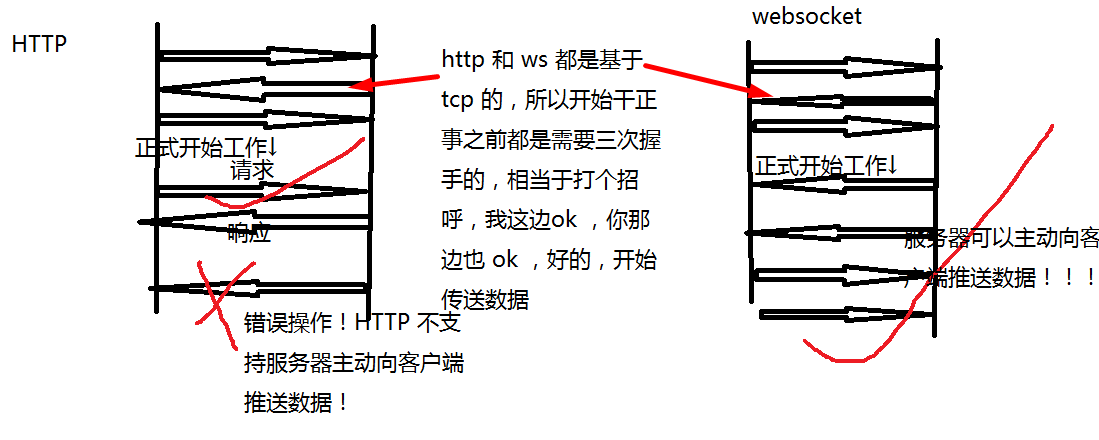本文的主要内容:
- HTTP VS. WebSocket
- WebSocket 的客户端实现(JavaScript)
- WebSocket 的服务端实现(Java & apache WebSocketAPI)
- WebSocket 深入学习
HTTP VS. WebSocket
简单来讲, WebSocket 就是一种允许服务端主动向客户端 PUSH 数据的技术。
传统的 HTTP 只能是客户端先主动向服务器发起请求然后获得服务器响应。
WebSocket是HTML5开始提供的一种在单个 TCP 连接上进行全双工通讯的协议。
在WebSocket API中,浏览器和服务器只需要做一个握手的动作,然后,浏览器和服务器之间就形成了一条快速通道。两者之间就直接可以数据互相传送。
浏览器通过 JavaScript 向服务器发出建立 WebSocket 连接的请求,连接建立以后,客户端和服务器端就可以通过 TCP 连接直接交换数据。
当你获取 Web Socket 连接后,你可以通过 send() 方法来向服务器发送数据,并通过 onmessage 事件来接收服务器返回的数据。
上面是网络上对于 websocket 的一段简短介绍。
值得一提的是,有不少人认为 websocket (于2011年被IETF定为标准RFC 6455)是一项可以取代 AJAX (约 1998 年前后得到应用)的技术。
简单的草图(。。自己画的不太极不严谨,例如说ws最开始有个 HTTP 验证漏掉了。。但是可以表达大概意思吧):

然后是我收集的一些关于 websocket 的资料:
1、WebSocket - Wikipedia 比较权威、全面
2、An Introduction to WebSockets - Treehouse Blog 生动的个人博客
3、websocket.org - Powered by Kaazing 以 websocket 为主题的网站!(websocket.org - WebSocket technology, demos, articles, and products.)
4、菜鸟教程之 websocket 赶时间的看这个。
总而言之,websocket 非常强大,应用也非常多,例如说可以用来构建基于浏览器的网页游戏、即时聊天工具之类的。
顺便收藏(主题无关 ~ ):
What's the difference between getRequestURI and getPathInfo methods in HttpServletRequest?
WebSocket 的客户端实现(JavaScript)
客户端代码完全拷贝自上面列出来的资料二:
index.html
<!DOCTYPE html> <html lang="en"> <head> <meta charset="utf-8"> <title>WebSockets Demo</title> <link rel="stylesheet" href="style.css"> </head> <body> <div id="page-wrapper"> <h1>WebSockets Demo</h1> <div id="status">Connecting...</div> <ul id="messages"></ul> <form id="message-form" action="#" method="post"> <textarea id="message" placeholder="Write your message here..." required></textarea> <button type="submit">Send Message</button> <button type="button" id="close">Close Connection</button> </form> </div> <script src="app.js"></script> </body> </html>
/
style.css

*, *:before, *:after { -moz-box-sizing: border-box; -webkit-box-sizing: border-box; box-sizing: border-box; } html { font-family: Helvetica, Arial, sans-serif; font-size: 100%; background: #333; } #page-wrapper { width: 650px; background: #FFF; padding: 1em; margin: 1em auto; border-top: 5px solid #69c773; box-shadow: 0 2px 10px rgba(0,0,0,0.8); } h1 { margin-top: 0; } #status { font-size: 0.9rem; margin-bottom: 1rem; } .open { color: green; } .closed { color: red; } ul { list-style: none; margin: 0; padding: 0; font-size: 0.95rem; } ul li { padding: 0.5rem 0.75rem; border-bottom: 1px solid #EEE; } ul li:first-child { border-top: 1px solid #EEE; } ul li span { display: inline-block; width: 90px; font-weight: bold; color: #999; font-size: 0.7rem; text-transform: uppercase; letter-spacing: 1px; } .sent { background-color: #F7F7F7; } .received {} #message-form { margin-top: 1.5rem; } textarea { width: 100%; padding: 0.5rem; font-size: 1rem; border: 1px solid #D9D9D9; border-radius: 3px; box-shadow: inset 0 1px 1px rgba(0, 0, 0, 0.1); min-height: 100px; margin-bottom: 1rem; } button { display: inline-block; border-radius: 3px; border: none; font-size: 0.9rem; padding: 0.6rem 1em; color: white; margin: 0 0.25rem; text-align: center; background: #BABABA; border-bottom: 1px solid #999; } button[type="submit"] { background: #86b32d; border-bottom: 1px solid #5d7d1f; } button:hover { opacity: 0.75; cursor: pointer; }
/
app.js
window.onload = function() { // Get references to elements on the page. var form = document.getElementById('message-form'); var messageField = document.getElementById('message'); var messagesList = document.getElementById('messages'); var socketStatus = document.getElementById('status'); var closeBtn = document.getElementById('close'); // The rest of the code in this tutorial will go here... // Create a new WebSocket. var socket = new WebSocket('ws://echo.websocket.org'); // Show a connected message when the WebSocket is opened. socket.onopen = function(event) { socketStatus.innerHTML = 'Connected to: ' + event.currentTarget.url; socketStatus.className = 'open'; }; // Handle any errors that occur. socket.onerror = function(error) { console.log('WebSocket Error: ' + error); }; // Send a message when the form is submitted. form.onsubmit = function(e) { e.preventDefault(); // Retrieve the message from the textarea. var message = messageField.value; // Send the message through the WebSocket. socket.send(message); // Add the message to the messages list. messagesList.innerHTML += '<li class="sent"><span>Sent:</span>' + message + '</li>'; // Clear out the message field. messageField.value = ''; return false; }; // Handle messages sent by the server. socket.onmessage = function(event) { var message = event.data; messagesList.innerHTML += '<li class="received"><span>Received:</span>' + message + '</li>'; }; // Show a disconnected message when the WebSocket is closed. socket.onclose = function(event) { socketStatus.innerHTML = 'Disconnected from WebSocket.'; socketStatus.className = 'closed'; }; // Close the WebSocket connection when the close button is clicked. closeBtn.onclick = function(e) { e.preventDefault(); // Close the WebSocket. socket.close(); return false; }; };
/
直接把 三个文件放在同一个目录下,用浏览器打开 index.html 就可以用了。连接的是代码原作者的 websocket 服务器。
WebSocket 的服务端实现(Java & apache WebSocketAPI)
构建WebSocket 服务器的方式有很多,不过我只会用 tomcat 的 API,代码即是 Tomcat 的 websocket example 相比自己写的肯定要规范些。↓

/* * Licensed to the Apache Software Foundation (ASF) under one or more * contributor license agreements. See the NOTICE file distributed with * this work for additional information regarding copyright ownership. * The ASF licenses this file to You under the Apache License, Version 2.0 * (the "License"); you may not use this file except in compliance with * the License. You may obtain a copy of the License at * * http://www.apache.org/licenses/LICENSE-2.0 * * Unless required by applicable law or agreed to in writing, software * distributed under the License is distributed on an "AS IS" BASIS, * WITHOUT WARRANTIES OR CONDITIONS OF ANY KIND, either express or implied. * See the License for the specific language governing permissions and * limitations under the License. */ package org.sample.web; import java.io.IOException; import java.util.Set; import java.util.concurrent.CopyOnWriteArraySet; import java.util.concurrent.atomic.AtomicInteger; import javax.websocket.OnClose; import javax.websocket.OnError; import javax.websocket.OnMessage; import javax.websocket.OnOpen; import javax.websocket.Session; import javax.websocket.server.ServerEndpoint; @ServerEndpoint(value = "/websocket") public class ChatAnnotation { private static final String GUEST_PREFIX = "Guest"; private static final AtomicInteger connectionIds = new AtomicInteger(0); private static final Set<ChatAnnotation> connections = new CopyOnWriteArraySet<>(); private final String nickname; private Session session; public ChatAnnotation() { nickname = GUEST_PREFIX + connectionIds.getAndIncrement(); } @OnOpen public void start(Session session) { this.session = session; connections.add(this); String message = String.format("* %s %s", nickname, "has joined."); broadcast(message); } @OnClose public void end() { connections.remove(this); String message = String.format("* %s %s", nickname, "has disconnected."); broadcast(message); } @OnMessage public void incoming(String message) { // Never trust the client String filteredMessage = String.format("%s: %s", nickname, message.toString()); broadcast(filteredMessage); } @OnError public void onError(Throwable t) throws Throwable { } private static void broadcast(String msg) { for (ChatAnnotation client : connections) { try { synchronized (client) { client.session.getBasicRemote().sendText(msg); } } catch (IOException e) { connections.remove(client); try { client.session.close(); } catch (IOException e1) { // Ignore } String message = String.format("* %s %s", client.nickname, "has been disconnected."); broadcast(message); } } } }
在运行之前需要修改 app.js 中的地址:
// The rest of the code in this tutorial will go here... // Create a new WebSocket. var socket = new WebSocket('ws://localhost:8080/websocket');
WebSocket 深入学习
当然,上面仅用到了 WebSocket API 的一个小子集,要想真正用好这些 API 并没那么简单。下面是我找到的一些学习资料(基本上看 URL 就知道什么内容了):
1、https://docs.oracle.com/javaee/7/api/javax/websocket/package-summary.html
2、https://docs.oracle.com/javaee/7/tutorial/websocket.htm
3、http://www.oracle.com/technetwork/articles/java/jsr356-1937161.html
4、https://developer.mozilla.org/en-US/docs/Web/API/WebSockets_API/Writing_a_WebSocket_server_in_Java
5、http://www.oracle.com/webfolder/technetwork/tutorials/obe/java/HomeWebsocket/WebsocketHome.html
6、http://www.baeldung.com/java-websockets
7、https://tomcat.apache.org/tomcat-9.0-doc/websocketapi/index.html
8、https://benas.github.io/2016/02/21/using-the-java-api-for-webSocket-to-create-a-chat-server.html
